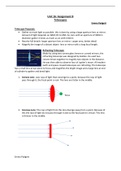Summary
Summary Unit 16 Assignment B
- Institution
- PEARSON (PEARSON)
Unit 16 Assignment B Overall Grade: Distinction Course Overall Grade: D*D Contains: telescopes. lenses, investigation notes, risk assessments, magnification equations, problems with telescopes, mirrors, concave, convex, resolving power, arrays, earth based telescopes, space based telescope...
[Show more]




